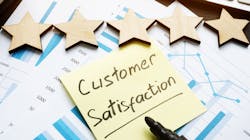Utilities Can Weather Volatility by Investing in Customer Satisfaction
When’s the last time your utility sent you a thank you note? If you’re like most customers, the answer is never. Utilities have historically been far more concerned with engineering and efficiency than they have been with delighting customers and managing relationships. The conventional logic was that utilities operated a bit like Major League Baseball umpires: The less you noticed them, the better they were doing.
It’s logical that this would be the case. Customers don’t have a lot of choice in their respective utility, and utilities usually don’t get much attention unless something has gone wrong. During the past decade, though, a string of events, ranging from frequent catastrophic weather events and a pandemic to widespread price volatility have made customer experience a top priority for regulated utilities.
Today, as utilities walk a tightrope between the end of pandemic-era financial relief, record high energy prices and much-needed infrastructure improvements, those that have made customer experience a top business objective are finding they are much better prepared to confront the difficult road ahead.
Justifying the Hikes
The hard truth is that most utilities are facing a massive challenge right now. The payment deferrals they offered to financially strained customers have lapsed. Simultaneously, virtually all utilities must pursue rate increases to keep up with growing infrastructure requirements and steadily rising commodity costs. That’s a tricky scenario to navigate without a good relationship with your customers. Now, not only is post-pandemic payment assistance more limited, for customers, but they also need to pay more than before.
Perhaps not surprisingly, customer satisfaction scores in the J.D. Power 2022 Electric Utility Residential Customer Satisfaction Study declined a significant 17 points (on a 1,000-point scale). The decline was almost entirely driven by customers getting angry about price increases.
It makes sense, especially when customers do not have a particularly strong relationship with their utility. They aren’t thinking about natural gas futures or that a single telephone pole now costs double what it did a few years ago. They are wondering if the utility executives are all getting raises or complaining about paying more to get the same level of service. As customers start to grumble, it’s easy to see why some utilities have aggressively pursued ways to shift the way their customers view them, from necessary evil to thoughtful partner.
After all, regulated utilities need to ask permission for rate increases, and those are far easier to get when customers are happy. Customers need to feel like they’re getting something for their money, and that can be difficult to quantify. After all, utilities are usually victims of a comparison of experiences. People aren’t comparing their electric company’s website to other utility websites. Instead, their site or their mobile app is being held up to standards set by Amazon or some other e-commerce site. The most successful utilities understand that, and they’re adopting strategies and language from those big consumer brands to explain how they plan to make their customer experience better.
The effort is worth making. When utilities have communicated clearly and customers remember those communications, satisfaction scores increased by 53 points. That’s important because those higher satisfaction scores directly correlate with positive regulatory outcomes.
The Culture of Satisfaction
How are the leaders doing this? Take PSE&G in New Jersey, for example.
According to J.D. Power data, PSE&G was in the middle of the pack in terms of customer satisfaction as recently as five years ago. But in the past few years, the utility has worked hard to improve its website, created phased projects for infrastructure improvements and trained and educated employees to prioritize customer satisfaction. Accordingly, customer satisfaction scores have risen steadily. In fact, while many utilities struggled with customer satisfaction last year, PSE&G took the top spot in the east large segment of our Electric Utility Residential Customer Satisfaction Study.
More Than One Way
Other leaders in the industry implementing other varied efforts have taken on several forms. Planned outages are clearly communicated with customers, and expectations properly set for how long service interruptions may last. If they effectively exceed customer expectations, those customers are even happier. If work required a crew to tear up a customer’s front yard, employees are given freedom to make repairs far ahead of schedule, sometimes even the day of service. Even an old-fashioned thank you note has gone a long way to letting customers know that a utility appreciated its patience.
For some industries, it may seem standard, even routine. But given the unique relationship between the two parties, prioritization of customer experience proves that utilities aren’t taking their customers for granted, even if those customers can’t shop their business to the power company down the street.
Staying Attuned
Ultimately, what gets prioritized usually gets done, and when utilities provide reasons for both their customers and their employees to work together toward a better partnership, these relationships improve. As utilities look to fend off future volatility and earn their customers’ trust, they’ll need to continue to stay engaged with their communities. That will mean continuing to find way to proactively communicate and treat customers like the stakeholders they are. The utilities that thrive at this will reap the benefits.
John Hazen is managing director of utility intelligence at J.D. Power. John is responsible for working with utilities across the United States to help them understand the importance of customer satisfaction and how to improve their customers’ experience. John joined J.D. Power in 2008 as director, voice of the customer.
About the Author
John Hazen
John Hazen is managing director of utility intelligence at J.D. Power. John is responsible for working with utilities across the United States to help them understand the importance of customer satisfaction and how to improve their customers’ experience. John joined J.D. Power in 2008 as director, voice of the customer.
